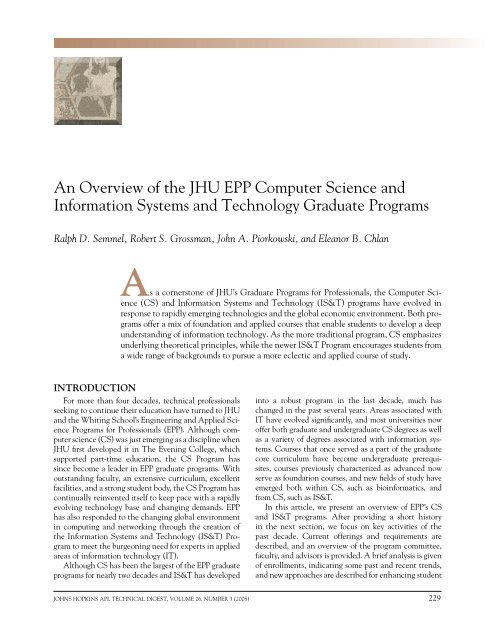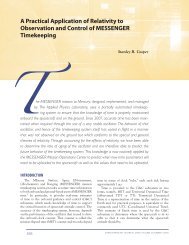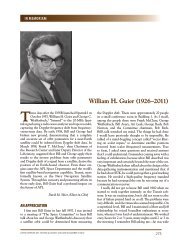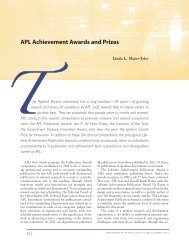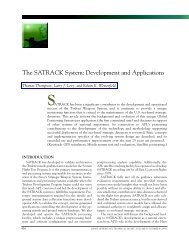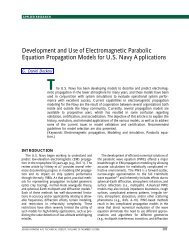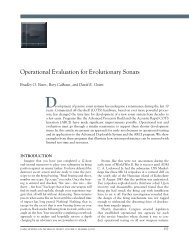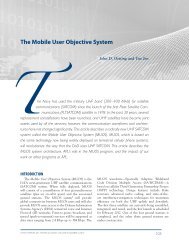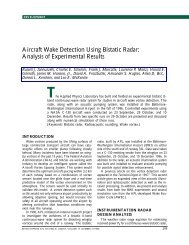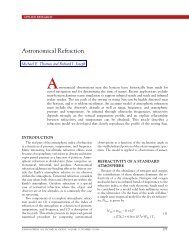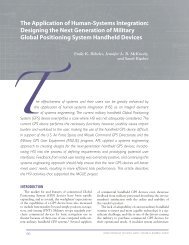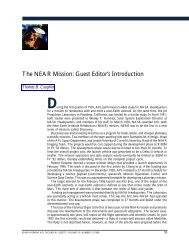An Overview of the JHU EPP Computer Science - Johns Hopkins ...
An Overview of the JHU EPP Computer Science - Johns Hopkins ...
An Overview of the JHU EPP Computer Science - Johns Hopkins ...
Create successful ePaper yourself
Turn your PDF publications into a flip-book with our unique Google optimized e-Paper software.
cs/is&T grADuATe progrAms<br />
<strong>An</strong> overview <strong>of</strong> <strong>the</strong> Jhu epp computer science and<br />
information systems and Technology graduate programs<br />
Ralph D. Semmel, Robert S. Grossman, John A. Piorkowski, and Eleanor B. Chlan<br />
As a cornerstone <strong>of</strong> Jhu’s graduate programs for pr<strong>of</strong>essionals, <strong>the</strong> computer science<br />
(cs) and information systems and Technology (is&T) programs have evolved in<br />
response to rapidly emerging technologies and <strong>the</strong> global economic environment. both programs<br />
<strong>of</strong>fer a mix <strong>of</strong> foundation and applied courses that enable students to develop a deep<br />
understanding <strong>of</strong> information technology. As <strong>the</strong> more traditional program, cs emphasizes<br />
underlying <strong>the</strong>oretical principles, while <strong>the</strong> newer is&T program encourages students from<br />
a wide range <strong>of</strong> backgrounds to pursue a more eclectic and applied course <strong>of</strong> study.<br />
INTRODUCTION<br />
For more than four decades, technical pr<strong>of</strong>essionals<br />
seeking to continue <strong>the</strong>ir education have turned to Jhu<br />
and <strong>the</strong> Whiting school’s engineering and Applied science<br />
programs for pr<strong>of</strong>essionals (epp). Although computer<br />
science (cs) was just emerging as a discipline when<br />
Jhu first developed it in The evening college, which<br />
supported part-time education, <strong>the</strong> cs program has<br />
since become a leader in epp graduate programs. With<br />
outstanding faculty, an extensive curriculum, excellent<br />
facilities, and a strong student body, <strong>the</strong> cs program has<br />
continually reinvented itself to keep pace with a rapidly<br />
evolving technology base and changing demands. epp<br />
has also responded to <strong>the</strong> changing global environment<br />
in computing and networking through <strong>the</strong> creation <strong>of</strong><br />
<strong>the</strong> information systems and Technology (is&T) program<br />
to meet <strong>the</strong> burgeoning need for experts in applied<br />
areas <strong>of</strong> information technology (iT).<br />
Although cs has been <strong>the</strong> largest <strong>of</strong> <strong>the</strong> epp graduate<br />
programs for nearly two decades and is&T has developed<br />
into a robust program in <strong>the</strong> last decade, much has<br />
changed in <strong>the</strong> past several years. Areas associated with<br />
iT have evolved significantly, and most universities now<br />
<strong>of</strong>fer both graduate and undergraduate cs degrees as well<br />
as a variety <strong>of</strong> degrees associated with information systems.<br />
courses that once served as a part <strong>of</strong> <strong>the</strong> graduate<br />
core curriculum have become undergraduate prerequisites,<br />
courses previously characterized as advanced now<br />
serve as foundation courses, and new fields <strong>of</strong> study have<br />
emerged both within cs, such as bioinformatics, and<br />
from cs, such as is&T.<br />
in this article, we present an overview <strong>of</strong> epp’s cs<br />
and is&T programs. After providing a short history<br />
in <strong>the</strong> next section, we focus on key activities <strong>of</strong> <strong>the</strong><br />
past decade. current <strong>of</strong>ferings and requirements are<br />
described, and an overview <strong>of</strong> <strong>the</strong> program committee,<br />
faculty, and advisors is provided. A brief analysis is given<br />
<strong>of</strong> enrollments, indicating some past and recent trends,<br />
and new approaches are described for enhancing student<br />
<strong>Johns</strong> hopkins ApL TechnicAL DigesT, VoLume 26, number 3 (2005) 229
. D. semmeL et al.<br />
opportunities based on partnerships and online courses.<br />
Finally, we highlight a few recent achievements before<br />
making concluding remarks.<br />
THE COMPUTER SCIENCE PROGRAM<br />
A Brief History<br />
courses in cs were initially <strong>of</strong>fered in Jhu’s parttime<br />
program in numerical science (now Applied and<br />
computational ma<strong>the</strong>matics) in <strong>the</strong> 1966–1967 academic<br />
year. in recognition <strong>of</strong> <strong>the</strong> emergence <strong>of</strong> cs as<br />
a discipline and <strong>the</strong> increasing popularity <strong>of</strong> <strong>the</strong> cs<br />
courses <strong>of</strong>fered at Jhu, a separate part-time cs program<br />
was established in 1971, with bob rich serving as <strong>the</strong><br />
first chair. The program rapidly grew into <strong>the</strong> largest<br />
program within epp, and by <strong>the</strong> early 1980s, more than<br />
80 sections <strong>of</strong> 34 classes were <strong>of</strong>fered in areas ranging<br />
from traditional topics in operating systems and compiler<br />
design to cutting-edge topics in graphics and networking.<br />
students were required to take two classes in<br />
<strong>the</strong> areas <strong>of</strong> languages, algorithms, and computational<br />
<strong>the</strong>ory, and <strong>the</strong> remaining classes were divided roughly<br />
into <strong>the</strong> areas <strong>of</strong> architecture and s<strong>of</strong>tware. <strong>of</strong> <strong>the</strong> faculty<br />
at <strong>the</strong> time, approximately 10 continue to serve,<br />
providing both continuity and a sense <strong>of</strong> tradition.<br />
in 1985, Vince sigillito was appointed chair, guiding<br />
<strong>the</strong> cs program during <strong>the</strong> evolution <strong>of</strong> <strong>the</strong> Whiting<br />
school’s part-Time programs in engineering and<br />
Applied science. 1 by <strong>the</strong> late 1980s, cs as a field <strong>of</strong><br />
study had evolved, and some <strong>of</strong> <strong>the</strong> lower-level and<br />
introductory courses <strong>the</strong>n <strong>of</strong>fered in <strong>the</strong> program were<br />
converted to undergraduate prerequisites, increasing<br />
<strong>the</strong> rigor <strong>of</strong> <strong>the</strong> program and making it more appealing<br />
for <strong>the</strong> increasing number <strong>of</strong> incoming students that<br />
held bachelor’s degrees in cs. in addition, cs was one<br />
<strong>of</strong> <strong>the</strong> initial programs to <strong>of</strong>fer courses in montgomery<br />
county, which has led to its strong presence today at <strong>the</strong><br />
montgomery county campus (mcc).<br />
by 1990, more than 70 courses were <strong>of</strong>fered at ApL<br />
and mcc, with strong interest in <strong>the</strong> areas <strong>of</strong> artificial<br />
intelligence, data communications, and s<strong>of</strong>tware engineering.<br />
All <strong>of</strong> <strong>the</strong>se areas had numerous course <strong>of</strong>ferings<br />
with large enrollments each semester. cs students<br />
could also choose an option in Telecommunications,<br />
which was <strong>of</strong>fered jointly with what was at <strong>the</strong> time<br />
<strong>the</strong> electrical engineering (ee) program. This option<br />
enabled students to take a variety <strong>of</strong> telecommunications<br />
courses from both cs and ee.<br />
in 1994, sigillito retired, and long-time faculty member<br />
and Vice chair robert grossman became program<br />
chair. Then in 1996, ralph semmel assumed program<br />
leadership, and grossman continued on as Vice chair.<br />
The Program Today<br />
interest in <strong>the</strong> focal areas <strong>of</strong> <strong>the</strong> early 1990s began<br />
to wane, but with <strong>the</strong> growing popularity <strong>of</strong> <strong>the</strong><br />
internet, <strong>the</strong> advent <strong>of</strong> <strong>the</strong> World Wide Web, and <strong>the</strong><br />
dot-com boom <strong>the</strong>re emerged an immense interest in<br />
communications systems, networking, and distributed<br />
computing. The Telecommunications option ultimately<br />
evolved into <strong>the</strong> Telecommunications and networking<br />
option that continues to be jointly <strong>of</strong>fered with what<br />
is today <strong>the</strong> electrical and computer engineering program.<br />
richard nieporent <strong>of</strong> miTre has long served as<br />
<strong>the</strong> cs coordinator for this option and has played an<br />
instrumental role in developing a robust set <strong>of</strong> <strong>of</strong>ferings<br />
and attracting key faculty.<br />
in 1996, marty hall, who had been one <strong>of</strong> <strong>the</strong> cs<br />
program’s principal artificial intelligence instructors,<br />
developed and <strong>of</strong>fered a new course, Distributed Development<br />
on <strong>the</strong> World Wide Web. The course was hugely<br />
successful, and hall went on to write a best-selling book<br />
based on <strong>the</strong> materials he developed for <strong>the</strong> course. 2<br />
The book has been translated into multiple languages<br />
and adopted by universities throughout <strong>the</strong> world.<br />
hall joined <strong>the</strong> program committee in 2001 and<br />
played a key role in winning a multi-year award through<br />
<strong>the</strong> maryland Applied information Technology initiative<br />
that supported <strong>the</strong> development <strong>of</strong> new cs courses.<br />
he <strong>the</strong>n teamed with hash malik, a fellow program<br />
committee and faculty member, to guide <strong>the</strong> creation<br />
<strong>of</strong> a concentration area in Distributed computing that<br />
today includes nine courses. significantly, hall later<br />
prepared a second edition <strong>of</strong> his best-selling book with<br />
ano<strong>the</strong>r epp cs faculty member, Larry brown. 3 hall<br />
and brown have also written a two-volume follow-on<br />
book set, which is in its second edition, that is used in<br />
some <strong>of</strong> <strong>the</strong> advanced distributed computing classes. 4,5<br />
The cs program has also developed comprehensive<br />
<strong>of</strong>ferings in o<strong>the</strong>r areas <strong>of</strong> emerging importance in<br />
recent years. For instance, a bioinformatics concentration<br />
area was established to enable students to develop<br />
expertise in computational biology. ed Addison, a successful<br />
entrepreneur with a strong interest and significant<br />
expertise in bioinformatics, assumed leadership <strong>of</strong><br />
<strong>the</strong> initiative and established <strong>the</strong> bioinformatics concentration<br />
area which now has eight courses. in addition,<br />
a separate Advanced certificate for post master’s<br />
study in bioinformatics was established that enables<br />
students to focus intensely in <strong>the</strong> field and take related<br />
courses outside <strong>the</strong> Whiting school <strong>of</strong> engineering.<br />
moreover, in 2002, epp and <strong>the</strong> krieger school <strong>of</strong> Arts<br />
and sciences teamed to create a joint master’s Degree<br />
program in bioinformatics consisting <strong>of</strong> cs and biology<br />
courses from both schools. Finally, in 2005, Jhu’s<br />
Academic council approved an online version <strong>of</strong> <strong>the</strong><br />
degree program.<br />
A recent initiative in cs stems from recognition <strong>of</strong><br />
<strong>the</strong> increasing vulnerability <strong>of</strong> computing systems and<br />
<strong>the</strong> significant economic and productivity impacts due<br />
to information systems succumbing to malicious attacks.<br />
As a result, a new concentration area in information<br />
230 <strong>Johns</strong> hopkins ApL TechnicAL DigesT, VoLume 26, number 3 (2005)
security was established in 2002. This area was coordinated<br />
with gerry masson, who at <strong>the</strong> time served<br />
as chair <strong>of</strong> homewood’s cs Department and now<br />
serves as Director <strong>of</strong> Jhu’s information security institute<br />
(Jhuisi). There are now nine courses <strong>of</strong>fered in<br />
information security, and Jhuisi students can take<br />
many <strong>of</strong> <strong>the</strong>m.<br />
EMERGENCE OF THE<br />
INFORMATION SYSTEMS<br />
AND TECHNOLOGY PROGRAM<br />
At <strong>the</strong> height <strong>of</strong> <strong>the</strong> dot-com boom in <strong>the</strong> latter part<br />
<strong>of</strong> <strong>the</strong> 1990s, <strong>the</strong> demand for iT courses <strong>of</strong> all types was<br />
high. students with diverse backgrounds were seeking<br />
to enter <strong>the</strong> iT field, even if <strong>the</strong>y did not have technical<br />
degrees. in response to <strong>the</strong> growing national demand for<br />
iT education, many universities established iT departments,<br />
and sometimes even schools. students flocked to<br />
<strong>the</strong>se programs, but many were seeking deeper technical<br />
insights and less emphasis on <strong>the</strong> business-oriented<br />
courses that were <strong>of</strong>ten core to those programs.<br />
While students from all technical disciplines have<br />
always been welcome to join <strong>the</strong> cs program, <strong>the</strong> prerequisites<br />
in math and cs can be daunting for those with<br />
degrees in disciplines such as education or business. epp<br />
recognized <strong>the</strong> need for a program that would be technically<br />
rich while appealing to a broader student body<br />
than that comprising cs. consequently, in 1997, epp<br />
established a new master’s Degree program in is&T.<br />
semmel and roger Westgate, who had been Associate<br />
Dean responsible for part-time engineering education<br />
and <strong>the</strong>n acting Dean <strong>of</strong> Jhu’s Whiting school <strong>of</strong><br />
engineering, gave a detailed description <strong>of</strong> <strong>the</strong> inception<br />
<strong>of</strong> <strong>the</strong> is&T program in an earlier Technical Digest<br />
article. 6 given <strong>the</strong> program’s initial leveraging <strong>of</strong> applied<br />
cs courses, semmel served as <strong>the</strong> first chair. he turned<br />
over chair responsibilities to bruce coury in 1998 but<br />
continued his association as cs coordinator for is&T.<br />
coury, at <strong>the</strong> time an ApL researcher and former pr<strong>of</strong>essor<br />
in industrial engineering, could serve as chair<br />
for only 1 year and transitioned leadership to Allan<br />
bjerkaas in 1999.<br />
upon being appointed Associate Dean for epp,<br />
bjerkaas asked semmel to again assume leadership <strong>of</strong> <strong>the</strong><br />
program in 2002. in his second tour as chair, semmel<br />
appointed John piorkowski as <strong>the</strong> is&T coordinator.<br />
in this role, piorkowski, an ApL staff member who<br />
had been teaching and advising in <strong>the</strong> is&T program,<br />
assumed responsibility for many <strong>of</strong> <strong>the</strong> is&T planning<br />
and operational activities.<br />
by design, is&T is <strong>the</strong> most eclectic degree program<br />
<strong>of</strong>fered in epp. students can take nonelective courses<br />
from is&T, cs, systems engineering, and Technical<br />
management as well as two elective courses from up to<br />
two additional epp programs. This eclectic orientation<br />
cs/is&T grADuATe progrAms<br />
has made is&T a natural focal point for collaborative<br />
efforts with o<strong>the</strong>r Jhu schools. For example, is&T has<br />
led an effort for epp in a joint initiative with <strong>the</strong> school<br />
<strong>of</strong> pr<strong>of</strong>essional studies in business and education to<br />
<strong>of</strong>fer <strong>the</strong> five-course graduate certificate in Technical<br />
innovation and new Ventures.<br />
PROGRAM HIGHLIGHTS OF THE<br />
PAST 10 YEARS<br />
Offerings and Requirements<br />
There are currently nine concentration areas in <strong>the</strong><br />
cs program, and more than 80 graduate courses and 5<br />
undergraduate prerequisite courses are <strong>of</strong>fered (see <strong>the</strong><br />
box, cs concentration Areas). students must take a set<br />
<strong>of</strong> three foundation courses in algorithm analysis, computer<br />
architecture, and s<strong>of</strong>tware engineering, and <strong>the</strong>n<br />
three courses in a concentration area <strong>of</strong> <strong>the</strong>ir choice.<br />
The remaining courses are electives, two <strong>of</strong> which may<br />
be taken from relevant programs outside cs. highly<br />
qualified students nearing completion <strong>of</strong> <strong>the</strong> degree<br />
may pursue independent study with cs faculty to add<br />
depth in a particular area or to pursue specific research<br />
interests.<br />
At <strong>the</strong> undergraduate level, students who are seeking<br />
a master’s degree in cs and who are entering from<br />
fields outside cs are expected to hold a technical degree<br />
and have taken courses in Java or c++, data structures,<br />
machine organization, and discrete ma<strong>the</strong>matics or o<strong>the</strong>r<br />
math courses beyond calculus ii. students who have not<br />
satisfied <strong>the</strong>se prerequisites may take <strong>the</strong> undergraduate<br />
courses <strong>of</strong>fered by Jhu. similarly, students entering bioinformatics<br />
but who do not have biology backgrounds<br />
must take undergraduate courses in biology and biochemistry.<br />
To facilitate <strong>the</strong> entrance <strong>of</strong> cs and o<strong>the</strong>r<br />
engineering students into <strong>the</strong> bioinformatics program,<br />
a special cs undergraduate course has been developed<br />
that covers <strong>the</strong> necessary molecular biology needed for<br />
graduate bioinformatics classes.<br />
The is&T curriculum is structured similarly to <strong>the</strong><br />
cs curriculum. students start with three required<br />
foundation courses in s<strong>of</strong>tware engineering, networking<br />
and telecommunications, and decision support<br />
systems. The course in s<strong>of</strong>tware engineering is <strong>the</strong><br />
same foundation course required <strong>of</strong> students pursuing a<br />
graduate degree in cs, while <strong>the</strong> o<strong>the</strong>r two are tailored<br />
for <strong>the</strong> is&T graduate degree and are not available to<br />
cs students. The remaining courses must include at<br />
least two advanced is&T courses. up to two electives<br />
outside is&T are permitted, with students typically<br />
choosing courses in cs, Technical management, and<br />
systems engineering.<br />
While is&T does not have concentration areas, <strong>the</strong><br />
<strong>of</strong>ferings are being evaluated to create areas that could<br />
serve as a basis for a depth requirement similar to that in<br />
cs. currently, 14 is&T-specific courses are <strong>of</strong>fered (see<br />
<strong>Johns</strong> hopkins ApL TechnicAL DigesT, VoLume 26, number 3 (2005) 231
. D. semmeL et al.<br />
CS CONCENTRATION AREAS AND COURSES<br />
Undergraduate Prerequisite Courses<br />
605.201 introduction to programming using<br />
Java<br />
605.202 Data structures<br />
605.203 Discrete ma<strong>the</strong>matics<br />
605.204 computer organization<br />
605.205 molecular biology for computer<br />
scientists<br />
Graduate Concentration Areas and Courses<br />
I. S<strong>of</strong>tware Engineering<br />
605.401 Foundations <strong>of</strong> s<strong>of</strong>tware engineering<br />
605.402 s<strong>of</strong>tware <strong>An</strong>alysis and Design<br />
605.403 s<strong>of</strong>tware project management<br />
605.404 object-oriented programming with<br />
c++<br />
605.405 conceptual Design for high performance<br />
systems<br />
605.701 Tools and Techniques <strong>of</strong> s<strong>of</strong>tware<br />
project management<br />
605.703 s<strong>of</strong>tware reuse<br />
605.704 object-oriented <strong>An</strong>alysis and Design<br />
605.705 s<strong>of</strong>tware safety<br />
605.706 The s<strong>of</strong>tware Development process<br />
605.707 s<strong>of</strong>tware patterns<br />
605.709 seminar in s<strong>of</strong>tware engineering<br />
II. Systems<br />
605.411 Foundations <strong>of</strong> computer Architecture<br />
605.414 s<strong>of</strong>tware Development in <strong>the</strong> unix<br />
environment<br />
605.711 contemporary computer Architecture<br />
605.713 robotics<br />
605.714 system Development in <strong>the</strong> unix<br />
environment<br />
605.715 s<strong>of</strong>tware Development for real-Time<br />
systems<br />
III. Theory<br />
605.421 Foundations <strong>of</strong> Algorithms<br />
605.423 Applied combinatorics and Discrete<br />
ma<strong>the</strong>matics<br />
605.424 Logical Foundations <strong>of</strong> computer<br />
science<br />
605.425 compiler Theory and Design<br />
605.721 Design and <strong>An</strong>alysis <strong>of</strong> Algorithms<br />
605.722 computational complexity<br />
605.723 signal processing<br />
605.725 Queuing Theory with Applications to<br />
computer science<br />
605.727 computational geometry<br />
605.728 Quantum computation<br />
IV. Information Security<br />
605.431 principles <strong>of</strong> enterprise security and<br />
privacy<br />
605.432 public key infrastructure and managing<br />
e-security<br />
605.433 embedded computer systems—Vulnerabilities,<br />
intrusions, and protection<br />
mechanisms<br />
605.434 WWW security<br />
605.731 network security<br />
605.732 cryptology<br />
605.733 Java and Web services security<br />
605.734 information Assurance<br />
605.735 biometrics<br />
V. Database Systems and Knowledge Management<br />
605.441 principles <strong>of</strong> Database systems<br />
605.445 Artificial intelligence<br />
605.447 neural networks<br />
605.741 Distributed Database systems on <strong>the</strong><br />
World Wide Web<br />
605.742 xmL: Technology and Applications<br />
605.744 information retrieval<br />
605.745 reasoning under uncertainty<br />
605.746 machine Learning and Data mining<br />
605.747 evolutionary computation<br />
VI. Bioinformatics<br />
605.451 principles <strong>of</strong> computational biology<br />
605.452 biological Databases and Database<br />
Tools<br />
605.751 computational Aspects <strong>of</strong> molecular<br />
structure<br />
605.752 simulation <strong>of</strong> biological and complex<br />
systems<br />
605.753 computational genomics<br />
605.754 <strong>An</strong>alysis <strong>of</strong> gene expression<br />
605.755 systems biology<br />
605.759 independent project in bioinformatics<br />
VII. Visualization and Human–<strong>Computer</strong> Interaction<br />
605.461 principles <strong>of</strong> computer graphics<br />
605.462 Data Visualization<br />
605.463 image processing<br />
605.465 natural Language processing<br />
605.761 Applied computer graphics<br />
605.766 human–computer interaction<br />
VIII. Data Communications and Networking<br />
605.471 principles <strong>of</strong> Data communications<br />
networks<br />
605.472 computer network Architectures and<br />
protocols<br />
605.475 protocol Design<br />
605.477 internetworking with Tcp/ip i<br />
605.478 cellular communications systems<br />
605.771 Local Area networks<br />
605.772 network management<br />
605.773 high-speed networking Technologies<br />
605.774 network programming<br />
605.777 internetworking with Tcp/ip ii<br />
605.778 Voice over ip<br />
IX. Distributed Computing<br />
605.481 Distributed Development on <strong>the</strong> World<br />
Wide Web<br />
605.482 user interface Development with <strong>the</strong><br />
Java Foundation classes<br />
605.485 electronic commerce<br />
605.781 Distributed objects<br />
605.782 Web Application Development with<br />
servlets and Javaserver pages (Jsp)<br />
605.783 reusable s<strong>of</strong>tware components with<br />
Javabeans<br />
605.784 enterprise computing with Java<br />
605.785 Web services: Framework, process, and<br />
Applications<br />
605.786 enterprise system Design and<br />
implementation<br />
Graduate Special Topics Courses<br />
605.791 new Technical Ventures<br />
605.792 computer ethics<br />
232 <strong>Johns</strong> hopkins ApL TechnicAL DigesT, VoLume 26, number 3 (2005)
<strong>the</strong> box, is&T-specific graduate courses),<br />
3 <strong>of</strong> which are cross-listed directly as cs<br />
courses. in addition, 25 courses from cs and<br />
4 courses in Technical management and systems<br />
engineering are co-listed in is&T for a<br />
total <strong>of</strong> 42 courses.<br />
starting with <strong>the</strong> spring 2006 semester,<br />
is&T students will be able to enroll in<br />
a capstone course. The capstone is designed<br />
for those desiring to engage in a major independent<br />
project involving a substantial<br />
enterprise information system design that<br />
incorporates several elements <strong>of</strong> <strong>the</strong> is&T<br />
curriculum. The capstone has a broader focus<br />
than independent study and specific required<br />
components.<br />
At <strong>the</strong> undergraduate level, is&T stu-<br />
dents, like <strong>the</strong>ir counterparts in cs, are expected to<br />
have completed courses in Java or c++ and data structures.<br />
They are also expected to have taken a year <strong>of</strong> college<br />
ma<strong>the</strong>matics, but courses such as finite ma<strong>the</strong>matics<br />
may be substituted for <strong>the</strong> calculus sequence required <strong>of</strong><br />
cs students. The goal is to minimize <strong>the</strong> entry prerequisites<br />
for students coming from nontechnical disciplines<br />
while ensuring that students will have sufficient underpinnings<br />
to complete <strong>the</strong> is&T-specific courses and <strong>the</strong><br />
selected set <strong>of</strong> applied cs courses. The prerequisites also<br />
serve is&T students well when <strong>the</strong>y take systems engineering<br />
and technical management graduate courses as<br />
part <strong>of</strong> <strong>the</strong>ir core curriculum.<br />
For students wishing to continue in formal education<br />
programs once <strong>the</strong>ir degrees are complete, an Advanced<br />
certificate for post master’s study in cs or is&T is<br />
<strong>of</strong>fered and may be completed by students who hold a<br />
master’s degree in cs, is&T, or a closely related discipline.<br />
students take six courses, five <strong>of</strong> which come from<br />
ei<strong>the</strong>r cs or is&T and one <strong>of</strong> which can be taken from<br />
o<strong>the</strong>r programs.<br />
in both <strong>the</strong> cs and is&T programs, faculty members<br />
and students are expected to focus on underlying fundamentals<br />
in courses ra<strong>the</strong>r than specific applications or<br />
commercial systems. While several courses also enable<br />
students to develop expertise in particular applicationoriented<br />
topics (e.g., programming languages), <strong>the</strong> intent<br />
is to impart foundation knowledge that will enable students<br />
to work with a wide range <strong>of</strong> existing and emerging<br />
information technologies.<br />
Program Committee and Advisors<br />
The cs and is&T programs are led by a program<br />
committee with 12 members. half <strong>of</strong> <strong>the</strong> members are<br />
from or have close affiliations with ApL, and <strong>the</strong> o<strong>the</strong>r<br />
half are drawn from industry, government, and academia.<br />
The committee meets annually to discuss <strong>the</strong><br />
state <strong>of</strong> <strong>the</strong> programs, evaluate initiatives, and propose<br />
and endorse objectives for <strong>the</strong> next year. At <strong>the</strong> annual<br />
cs/is&T grADuATe progrAms<br />
IS&T-SPECIFIC GRADUATE COURSES<br />
635.411 Foundations <strong>of</strong> networking and Telecommunications<br />
635.412 Local and Wide Area network Technologies<br />
635.413 ip networking and Applications<br />
635.421 Foundations <strong>of</strong> Decision support systems<br />
635.431 information systems Architectures and methodologies<br />
635.476 information systems security<br />
635.482 Web site Development<br />
635.483 electronic commerce<br />
635.711 internetworking: methods, Technologies, and Devices<br />
635.721 human–computer interaction<br />
635.731 Distributed Architectures<br />
635.781 xmL: Technology and Applications<br />
635.792 management <strong>of</strong> innovation<br />
635.795 information systems and Technology capstone project<br />
faculty meeting held each spring, <strong>the</strong> program chair<br />
presents a summary <strong>of</strong> program committee discussions<br />
and decisions.<br />
To help students in developing plans <strong>of</strong> study, <strong>the</strong> cs<br />
and is&T programs have 11 advisors. Advisors evaluate<br />
and approve student program plans, assist with registrations<br />
and open houses, and answer student questions on<br />
CS AND IS&T PROGRAM COMMITTEE<br />
ralph D. semmel, cs and is&T program chair<br />
principal pr<strong>of</strong>essional staff, ApL<br />
robert s. grossman, cs program Vice chair<br />
principal pr<strong>of</strong>essional staff, ApL<br />
John A. piorkowski, is&T coordinator<br />
principal pr<strong>of</strong>essional staff, ApL<br />
marty hall<br />
president, coreservlets.com inc.<br />
horace malcom<br />
principal pr<strong>of</strong>essional staff, ApL<br />
hashmat malik<br />
president, s<strong>of</strong>tware productivity strategists inc.<br />
robert L. martino<br />
Division <strong>of</strong> computer research and Technology,<br />
national institutes <strong>of</strong> health<br />
richard J. nieporent<br />
senior principal engineer, miTre corporation<br />
John sadowsky<br />
scientist, Leading edge Design and systems<br />
Vincent g. sigillito<br />
principal pr<strong>of</strong>essional staff (ret.), ApL<br />
scott smith<br />
pr<strong>of</strong>essor and chair, computer science, Whiting school<br />
<strong>of</strong> engineering<br />
J. miller Whisnant<br />
principal pr<strong>of</strong>essional staff, ApL<br />
<strong>Johns</strong> hopkins ApL TechnicAL DigesT, VoLume 26, number 3 (2005) 233
. D. semmeL et al.<br />
an ad hoc basis. Three advisors play special roles. eleanor<br />
chlan, who was also recently appointed as epp’s<br />
first full-time senior Lecturer, advises students who do<br />
not have degrees in cs or is&T and who do not satisfy<br />
<strong>the</strong> minimum course requirements for direct admission<br />
into <strong>the</strong> graduate programs. robin grasso advises bioinformatics<br />
students. grasso also has developed a handbook<br />
that is used for all cs and is&T advisors, and she<br />
distributes updates to <strong>the</strong> handbook annually. richard<br />
nieporent advises cs students enrolled in <strong>the</strong> Telecommunications<br />
and networking option.<br />
one issue that cs and is&T advisors face more frequently<br />
stems from <strong>the</strong> nation’s increasingly mobile society.<br />
students are more <strong>of</strong>ten applying to <strong>the</strong> programs<br />
after transferring to <strong>the</strong> area. many <strong>of</strong> <strong>the</strong>m have taken<br />
graduate courses with o<strong>the</strong>r colleges and universities and<br />
do not want to lose credit for <strong>the</strong> work <strong>the</strong>y have done.<br />
similarly, <strong>the</strong>re are students close to completion <strong>of</strong> <strong>the</strong>ir<br />
programs at Jhu who move from <strong>the</strong> area and do not<br />
want to lose <strong>the</strong>ir credit. Advisors work with students<br />
in both cases to develop options that will allow <strong>the</strong>m<br />
to leverage <strong>the</strong>ir work and complete <strong>the</strong>ir programs. For<br />
incoming students, up to two classes may be waived if<br />
a sufficient number <strong>of</strong> graduate courses have been successfully<br />
completed at o<strong>the</strong>r institutions. similarly, students<br />
who have left <strong>the</strong> area can work with advisors to<br />
develop a plan for completing <strong>the</strong>ir programs through<br />
Jhu online courses, Jhu independent study courses,<br />
and approved transfer courses from o<strong>the</strong>r institutions.<br />
Faculty Achievements<br />
between cs and is&T, <strong>the</strong>re are nearly 100 faculty<br />
members, all with graduate degrees and almost 40%<br />
with ph.D. degrees. About 20 faculty members have<br />
served with <strong>the</strong> programs for 20 years or longer. richard<br />
nieporent enjoys <strong>the</strong> distinction <strong>of</strong> <strong>the</strong> longest affiliation,<br />
having taught in <strong>the</strong> cs program since 1979.<br />
While it is not feasible to list all faculty achievements<br />
from <strong>the</strong> past decade, several recent accomplishments<br />
are representative. John sheppard and bunny Tjaden,<br />
for example, prepared three papers with epp students<br />
that were presented at conferences in 2004 and 2005.<br />
similarly, eleanor chlan presented a conference paper<br />
in 2005 based on her dissertation research, which is also<br />
serving as a basis for a new cs graduate course she is<br />
<strong>of</strong>fering in visualization.<br />
Although such recognition in conferences and journals<br />
is welcome and desired, <strong>the</strong> focus <strong>of</strong> <strong>the</strong> cs and<br />
is&T programs has always been on <strong>the</strong> classroom experience.<br />
Thus, faculty members are continually encouraged<br />
to enhance <strong>the</strong>ir courses. one approach that students<br />
particularly appreciate is <strong>the</strong> incorporation <strong>of</strong> hands-on<br />
labs and demonstrations in classes to augment lectures.<br />
over <strong>the</strong> years, cs and is&T faculty have developed a<br />
number <strong>of</strong> special laboratory facilities, with recent ones<br />
focused on communications and networking, distributed<br />
development, and information security. Jeff gustin has<br />
guided <strong>the</strong> newest addition in support <strong>of</strong> his real-time<br />
s<strong>of</strong>tware development class. gustin is having his students<br />
use Lego mindstorms kits and a real-time Java<br />
development environment to explore concepts based on<br />
small robots (Fig. 1).<br />
Enrollments<br />
From its start in <strong>the</strong> early 1970s, <strong>the</strong> cs program<br />
grew rapidly. enrollments peaked in <strong>the</strong> 1991–1993<br />
academic years at more than 3000 per year and <strong>the</strong>n<br />
dipped in response to a drooping national economy.<br />
enrollments picked up again as a result <strong>of</strong> <strong>the</strong> dot-com<br />
boom and peaked once more in <strong>the</strong> 1999–2002 academic<br />
years. The maximum number <strong>of</strong> annual enrollments<br />
during that period topped 3600 (Fig. 2 provides<br />
semester details).<br />
With <strong>the</strong> passing <strong>of</strong> <strong>the</strong> dot-com era, cs enrollments<br />
have declined. While <strong>the</strong> decrease is not surprising,<br />
several contributing factors are worth highlighting.<br />
First, cs enrollments at <strong>the</strong> undergraduate level have<br />
dropped precipitously nationwide. in fact, recent surveys<br />
indicate that <strong>the</strong> number <strong>of</strong> newly declared majors<br />
in cs declined 32% between 2000 and 2004, and <strong>the</strong><br />
number <strong>of</strong> incoming freshmen expressing an interest<br />
in majoring in cs dropped by 59% during that same<br />
period. 7 Although some anecdotal evidence indicates<br />
that undergraduate cs enrollments are stabilizing, and<br />
perhaps even starting to increase at some institutions,<br />
Figure 1. Use <strong>of</strong> LEGO Mindstorms for real-time s<strong>of</strong>tware<br />
development.<br />
234 <strong>Johns</strong> hopkins ApL TechnicAL DigesT, VoLume 26, number 3 (2005)
Number <strong>of</strong> enrollments<br />
1600<br />
1400<br />
1200<br />
1000<br />
800<br />
600<br />
400<br />
200<br />
0<br />
95–96 96–97 97–98 98–99 99–00 00–01 01–02 02–03 03–04 04–05<br />
Summer 554 563 601 710 640 786 814 722 674 615<br />
Fall 1228 1191 1297 1371 1460 1454 1403 1382 1225 1125<br />
Spring 1186 1173 1289 1439 1417 1423 1427 1332 1229 1168<br />
Academic year<br />
Figure 2. CS enrollments by semester for <strong>the</strong> past 10 academic years.<br />
<strong>the</strong>re will be a smaller pipeline <strong>of</strong> students for graduate<br />
cs programs, especially large ones like epp’s, for several<br />
years to come. A second, related factor is that s<strong>of</strong>tware<br />
development <strong>of</strong>fshoring and outsourcing have discouraged<br />
students who would o<strong>the</strong>rwise have pursued cs.<br />
This has occurred despite an anticipated demand for<br />
iT pr<strong>of</strong>essionals in <strong>the</strong> united states that significantly<br />
exceeds <strong>the</strong> expected supply. 8 Finally, many companies<br />
have become more frugal with tuition benefits, which<br />
has restricted <strong>the</strong> number <strong>of</strong> courses that students can<br />
take in a given year.<br />
in is&T, <strong>the</strong> enrollment picture is still evolving.<br />
starting with 9 enrollments in <strong>the</strong> spring <strong>of</strong> 1997, <strong>the</strong><br />
program has grown steadily and now has more than<br />
300 enrollments each academic year (Fig. 3). moreover,<br />
because <strong>of</strong> <strong>the</strong> eclectic nature <strong>of</strong> <strong>the</strong> program, in any<br />
given semester many is&T students take courses in<br />
o<strong>the</strong>r programs. The enrollments in courses outside<br />
is&T are attributed to <strong>the</strong> supporting program and are<br />
not included in <strong>the</strong> is&T enrollment numbers. A positive<br />
impact is that is&T has helped bolster enrollments<br />
in a number <strong>of</strong> epp programs, including cs.<br />
Partnerships<br />
<strong>An</strong> exciting development in <strong>the</strong><br />
last several years has been <strong>the</strong> establishment<br />
<strong>of</strong> educational partnerships<br />
with industry and government. This<br />
has been an epp thrust, and both<br />
cs and is&T have participated at a<br />
significant level. under <strong>the</strong> partnership<br />
programs, epp <strong>of</strong>fers a selection<br />
<strong>of</strong> courses at <strong>the</strong> location <strong>of</strong> a partner<br />
organization. students benefit from<br />
<strong>the</strong> convenience <strong>of</strong> <strong>the</strong> <strong>of</strong>ferings and<br />
from <strong>the</strong> explicit support given by<br />
managers and colleagues. employers<br />
benefit from <strong>the</strong> targeted education<br />
that is provided.<br />
Number <strong>of</strong> enrollments<br />
160<br />
140<br />
120<br />
100<br />
80<br />
60<br />
40<br />
20<br />
0<br />
cs/is&T grADuATe progrAms<br />
in cs, <strong>the</strong> partnerships have<br />
been focused on industry. With<br />
Lockheed martin, for example,<br />
cs is supporting <strong>the</strong> engineering<br />
Leadership Development program.<br />
Three cs courses are <strong>of</strong>fered at<br />
Lockheed martin and have been<br />
tailored to satisfy specific company<br />
requirements while retaining full<br />
academic rigor. The remaining<br />
courses are taken at epp educational<br />
centers, in particular at ApL<br />
and mcc, or online.<br />
is&T’s most significant partnership<br />
initiative has been with a coor-<br />
dinating government activity sup-<br />
porting multiple organizations. All required courses are<br />
<strong>of</strong>fered at a government site and are drawn from <strong>the</strong> set<br />
<strong>of</strong> is&T-specific and applied cs <strong>of</strong>ferings. significantly,<br />
<strong>the</strong>re are on <strong>the</strong> order <strong>of</strong> 100 enrollments per year in<br />
<strong>the</strong> is&T partnership program. in addition, a multi-year<br />
schedule has been developed that enables <strong>the</strong> partnership<br />
students to plan complete schedules early in <strong>the</strong>ir<br />
programs.<br />
Online Courses<br />
During <strong>the</strong> past several years, online courses have<br />
been gaining in popularity, and epp intends to increase<br />
<strong>the</strong> availability <strong>of</strong> both online classes and programs. surveys<br />
conducted by Jhu have shown that although <strong>the</strong><br />
direct interactions <strong>of</strong> a classroom setting are reduced,<br />
<strong>the</strong> convenience <strong>of</strong> online classes outweighs issues that<br />
might be associated with <strong>the</strong> online format. in particular,<br />
many part-time students travel for business and<br />
travel schedules cannot always be known at <strong>the</strong> beginning<br />
<strong>of</strong> a semester. online courses allow students to<br />
continue taking classes regardless <strong>of</strong> travel requirements.<br />
similarly, students who do not live in <strong>the</strong> area or who<br />
96–97 97–98 98–99 99–00 00–01 01–02 02–03 03–04 04–05<br />
Summer 2 22 68 68 80 69 81 80<br />
Fall 19 53 82 79 111 80 125 102<br />
Spring 9 32 64 89 115 112 110 110 147<br />
Academic year<br />
Figure 3. IS&T enrollments by semester since <strong>the</strong> program’s inception.<br />
<strong>Johns</strong> hopkins ApL TechnicAL DigesT, VoLume 26, number 3 (2005) 235
. D. semmeL et al.<br />
may have to move from <strong>the</strong> area can still take advantage<br />
<strong>of</strong> Jhu educational opportunities.<br />
in cs and is&T, faculty members are given <strong>the</strong><br />
opportunity to propose new online <strong>of</strong>ferings each<br />
year, and both programs are considering whe<strong>the</strong>r<br />
to <strong>of</strong>fer fully online degrees. currently, 10 cs and 3<br />
is&T courses are <strong>of</strong>fered online. While <strong>the</strong> number <strong>of</strong><br />
courses <strong>of</strong>fered appears to indicate that students could<br />
complete a degree online, not all required courses are<br />
yet <strong>of</strong>fered in that format. in particular, cs foundation<br />
courses are not online, although <strong>the</strong> course in foundations<br />
<strong>of</strong> algorithms is under development to support <strong>the</strong><br />
graduate bioinformatics program that will be <strong>of</strong>fered<br />
online in conjunction with <strong>the</strong> krieger school <strong>of</strong> Arts<br />
and sciences. in is&T, two <strong>of</strong> <strong>the</strong> foundation courses<br />
are <strong>of</strong>fered online.<br />
CONCLUSION<br />
cs is not <strong>the</strong> program it was more than 30 years ago,<br />
nor, for that matter, a decade ago. it has been continually<br />
reinvented in response to emerging technologies, student<br />
interests, employer needs, and economic demands.<br />
evolving from a set <strong>of</strong> s<strong>of</strong>tware development courses<br />
in ma<strong>the</strong>matics, it has become a vibrant and comprehensive<br />
program that has long served as an epp pillar.<br />
graduates <strong>of</strong> <strong>the</strong> program have both <strong>the</strong> <strong>the</strong>oretical<br />
foundations and hands-on experience needed to serve<br />
as technical and conceptual leaders in <strong>the</strong> development<br />
<strong>of</strong> complex information systems.<br />
is&T, a more recent addition to epp, has evolved into<br />
a robust program in its own right. Leveraging its base in<br />
cs, is&T has attracted a new community <strong>of</strong> students<br />
to epp. in some ways, <strong>the</strong>se students signal <strong>the</strong> future <strong>of</strong><br />
iT. graduates <strong>of</strong> <strong>the</strong> program have <strong>the</strong> appropriate mix<br />
<strong>of</strong> <strong>the</strong>ory, technology, and management to enable <strong>the</strong>m<br />
to lead diverse teams in developing solutions to complex<br />
information-based problems across a wide range <strong>of</strong><br />
areas.<br />
both programs have arrived at a juncture, with <strong>the</strong><br />
outlook for <strong>the</strong> future depending largely on perspective.<br />
some say that demand and enrollments will continue<br />
to diminish as globalization and outsourcing ultimately<br />
displace ever greater numbers <strong>of</strong> u.s. iT workers. o<strong>the</strong>rs<br />
contend that with demand for iT pr<strong>of</strong>essionals strong<br />
and growing, <strong>the</strong>re is a need for u.s. colleges and universities<br />
to increase <strong>the</strong> number <strong>of</strong> cs and is&T graduates.<br />
moreover, given <strong>the</strong> currently undersubscribed<br />
undergraduate programs across <strong>the</strong> nation, <strong>the</strong>re will be<br />
an even greater need for focused graduate programs to<br />
produce highly educated iT pr<strong>of</strong>essionals. As for us, we<br />
see iT playing ever more critical roles in all facets <strong>of</strong> life<br />
and are looking forward to a bright future as we enter<br />
<strong>the</strong> next stage <strong>of</strong> evolution for both <strong>the</strong> cs and is&T<br />
programs.<br />
AcknoWLeDgmenTs: The authors would like to<br />
acknowledge <strong>the</strong> commitment and achievements <strong>of</strong> <strong>the</strong><br />
past and present cs and is&T program committee<br />
members, advisors, and faculty. in addition, we would<br />
like to thank <strong>the</strong> epp administration and staff for <strong>the</strong>ir<br />
devoted efforts and significant contributions to <strong>the</strong>se<br />
programs. Finally, we would like to recognize <strong>the</strong> high<br />
caliber and hard work <strong>of</strong> our students, who inspire us to<br />
do our best.<br />
reFerences<br />
1 sigillito, V. g., “The master’s Degree program in computer science,”<br />
<strong>Johns</strong> <strong>Hopkins</strong> APL Tech. Dig. 10(2), 143–145 (1989).<br />
2 hall, m., Core Web Programming, prentice hall pTr, upper saddle<br />
river, nJ (1998).<br />
3 hall, m., and brown, L., Core Web Programming, 2nd ed., prentice<br />
hall pTr, upper saddle river, nJ (2001).<br />
4 hall, m., and brown, L., Core Servlets and Java Pages, Vol. 1, 2nd ed.,<br />
prentice hall pTr, upper saddle river, nJ (2003).<br />
5 hall, m., and brown, L., Core Servlets and Java Pages, Vol. 2, 2nd ed.,<br />
prentice hall pTr, upper saddle river, nJ (2006).<br />
6 semmel, r. D., and Westgate, c. r., “responding to critical educational<br />
needs: information systems and Technology,” <strong>Johns</strong> <strong>Hopkins</strong><br />
APL Tech. Dig. 18(2), 329–332 (1997).<br />
7 Foster, A., “student interest in computer science plummets,” Chronicle<br />
Higher Educ. 51(38), A31 (27 may 2005).<br />
8 Denning, p. J., and mcgettrick, A., “recentering computer science,”<br />
Commun. ACM 48(11), 15–19 (2005).<br />
236 <strong>Johns</strong> hopkins ApL TechnicAL DigesT, VoLume 26, number 3 (2005)
THE AUTHORS<br />
cs/is&T grADuATe progrAms<br />
Ralph D. Semmel serves as chair <strong>of</strong> <strong>the</strong> cs and is&T programs in Jhu’s Applied science programs for pr<strong>of</strong>essionals.<br />
Dr. semmel is a member <strong>of</strong> ApL’s principal pr<strong>of</strong>essional staff and heads <strong>the</strong> Laboratory’s Applied information sciences<br />
Department and infocentric operations business Area. his ph.D. is in computer science, and his<br />
research and teaching experience is in <strong>the</strong> areas <strong>of</strong> artificial intelligence and database systems.<br />
Robert S. Grossman is Vice chair <strong>of</strong> <strong>the</strong> cs program, where he has taught s<strong>of</strong>tware engineering for<br />
more than 20 years. Dr. grossman, who has a ph.D. in bioengineering, is an electrical and s<strong>of</strong>tware<br />
engineer at ApL and a member <strong>of</strong> <strong>the</strong> principal pr<strong>of</strong>essional staff. John A. Piorkowski serves as<br />
ralph D. semmel<br />
John A. piorkowski<br />
coordinator <strong>of</strong> <strong>the</strong> is&T program. mr. piorkowski is a member <strong>of</strong> <strong>the</strong> Laboratory’s principal pr<strong>of</strong>es-<br />
robert s. grossman<br />
eleanor b. chlan<br />
sional staff and head <strong>of</strong> <strong>the</strong> program management <strong>of</strong>fice in ApL’s Applied<br />
information sciences Department. he has an m.s. in electrical engineering<br />
and a post master’s certificate in telecommunications. mr. piorkowski<br />
has both engineering and teaching experience in <strong>the</strong> areas <strong>of</strong> networking<br />
and communications. Eleanor B. Chlan, whose ph.D. is in cs, is a full-time<br />
senior Lecturer with Jhu, supporting both <strong>the</strong> cs and is&T programs. Dr.<br />
chlan’s research and teaching interests are in <strong>the</strong> areas <strong>of</strong> information visualization<br />
and discrete structures. Fur<strong>the</strong>r information on <strong>the</strong> cs and is&T<br />
programs can be obtained from Dr. semmel. his e-mail address is ralph.semmel@jhuapl.edu.<br />
<strong>Johns</strong> hopkins ApL TechnicAL DigesT, VoLume 26, number 3 (2005) 237


